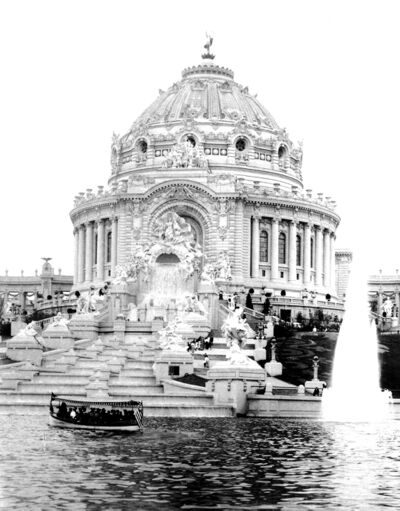Festival Hall: Difference between revisions
No edit summary |
No edit summary |
||
| (2 intermediate revisions by the same user not shown) | |||
| Line 2: | Line 2: | ||
{{Infobox FairBuilding | {{Infobox FairBuilding | ||
| name = Festival Hall | | name = Festival Hall | ||
| image = Festival Hall. | | image = Festival Hall.jpg | ||
| image_alt = | | image_alt = | ||
| image_size = 400px | | image_size = 400px | ||
| Line 14: | Line 14: | ||
| owner = | | owner = | ||
| architect = Cass Gilbert | | architect = Cass Gilbert | ||
| dimensions = | | dimensions = 200' OD, 200' Tall | ||
| adult_entry = | | adult_entry = | ||
| child_entry = | | child_entry = | ||
| Line 24: | Line 24: | ||
| ticket_image = | | ticket_image = | ||
}} | }} | ||
The Festival Hall was the centerpiece of the [[Main Picture]] at the Fair. It's breathtaking architecture was the single-most photographed building | The Festival Hall was the centerpiece of the [[Main Picture]] at the Fair. It's breathtaking architecture was the single-most photographed building. The Festival Hall's grand dome was reportedly larger than St. Peter's basilica in Rome. Evelyn Longman's “Victory” statue, stood on top of the Festival Hall. | ||
==Etymology== | ==Etymology== | ||
| Line 36: | Line 36: | ||
choir. The Chief of Design of the Exposition, E. L. Masqueray, of New York, created the building's interior. | choir. The Chief of Design of the Exposition, E. L. Masqueray, of New York, created the building's interior. | ||
The East and West Cascade Restaurants, (similar in design and in beauty), which could each seat 1,200 patrons bookended the Festival Hall. Behind the Festival Hall was the Colonnade of States, which featured a monument to the thirteen states and the `Indian Territory' that was gained by the United States from the Louisiana Purchase. | The [[East Cascade Restaurant|East]] and [[West Cascade Restaurant|West Cascade Restaurants]], (similar in design and in beauty), which could each seat 1,200 patrons bookended the Festival Hall. Behind the Festival Hall was the Colonnade of States, which featured a monument to the thirteen states and the `Indian Territory' that was gained by the United States from the Louisiana Purchase. | ||
In front of the Festival Hall were the Cascades located in front of Festival Hall and the Grand Basin. Pumps pushed 45,000 gallons of water a minute through man-made falls into the Grand Basin. | In front of the Festival Hall were the Cascades located in front of Festival Hall and the Grand Basin. Pumps pushed 45,000 gallons of water a minute through man-made falls into the Grand Basin. | ||
Latest revision as of 04:04, 4 March 2024
 | |
| Location | Main Picture |
|---|---|
| No. of Buildings | 1 |
| Construction | |
| Construction Cost | $218,430 (equivalent to $6,587,687 in 2021) |
| Architecture | |
| Architect | Cass Gilbert |
| Dimensions | 200' OD, 200' Tall |
The Festival Hall was the centerpiece of the Main Picture at the Fair. It's breathtaking architecture was the single-most photographed building. The Festival Hall's grand dome was reportedly larger than St. Peter's basilica in Rome. Evelyn Longman's “Victory” statue, stood on top of the Festival Hall.
Etymology[edit | edit source]
Before the Fair[edit | edit source]
Description[edit | edit source]
Gilbert was also an architecture juror at the 1893 World's Columbian Exposition in Chicago.
Inside, the auditorium contained seats for 3,500 people (some references say 4,500), and a stage large enough for hundreds of musicians and choir. The Chief of Design of the Exposition, E. L. Masqueray, of New York, created the building's interior.
The East and West Cascade Restaurants, (similar in design and in beauty), which could each seat 1,200 patrons bookended the Festival Hall. Behind the Festival Hall was the Colonnade of States, which featured a monument to the thirteen states and the `Indian Territory' that was gained by the United States from the Louisiana Purchase.
In front of the Festival Hall were the Cascades located in front of Festival Hall and the Grand Basin. Pumps pushed 45,000 gallons of water a minute through man-made falls into the Grand Basin.
Festival Hall was the home to the world’s largest pipe organ, the Wanamaker Organ
